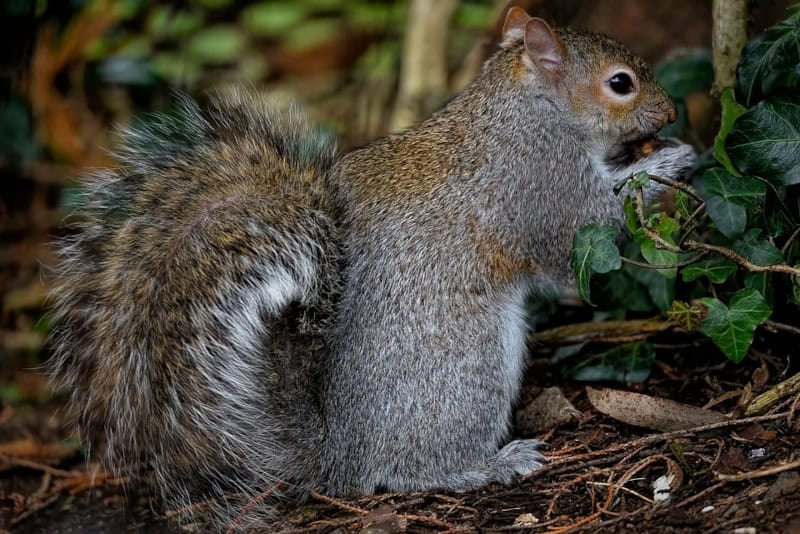
Eastern Gray Squirrel Facts
- The informative term of Eastern Gray Squirrel serves as the most frequently used common name for this beautiful product of evolution. The adorable mammal does have another, very similar title, though. That’s simply the moderately shorter term of the gray squirrel.
- Among scientific professionals, however, it’s generally referred to by its more formal title. Unfortunately, that technical moniker remains somewhat difficult for the layperson to pronounce. That’s because it bears the official name of the Sciurus carolinensis.
- The rodent received that tongue-twisting appellation due to the efforts of Johann Friedrich Gmelin. The respected German naturalist accomplished the first acknowledgement of the animal as a separate and distinct species. He managed that noteworthy deed in 1788.
- No matter which of these monikers one chooses to use, though, the mammal remains an interesting fauna. Despite its comparatively small stature, it plays a pivotal role in its region. In fact, the creature represents perhaps the most important regenerator of forests in its range.
- It’s therefore fortunate that the Eastern Gray Squirrel seems to be maintaining a population base that’s both stable and sufficient. That pleasant situation also appears to hold true throughout its territory. Accordingly, the IUCN lists it as Least Concern on its Red List.
- The marvel of Nature nevertheless still faces numerous potential threats to its continued existence as a species. Most of those, though, mirror the situation of many species. It faces the possible dangers of habitat degradation and loss, and of course, that of climate change.
Related Articles
Eastern Gray Squirrel Physical Description
The remarkable Eastern Gray Squirrel rarely fails to capture the attention and appreciation of those who encounter it. The delicate animal does so for various reasons, of course. Sheer physical measurements, however, rarely factor into the general degree of respect it’s usually accorded.
In that regard, the creature follows the pattern established by the majority of its kindred around the world. That’s true since it displays no noticeable degree of the phsyiological characteristic of sexual dimorphism. The genders, therefore, can be hard for the layperson to distinguish simply.
Individuals of both sexes of the animal attain a body length that averages somewhere between 9.1 – 11.8 in (23 – 30 cm). The tail, however, grows comparatively lengthy in relation to body size. This versatile appendage typically reaches lengths equaling between 7.5 – 9.8 in (19 – 25 cm).
Weights for this species remain surprisingly light, again among both genders. Mature adults usually reach a mass equaling between 14 – 21 oz (0.4 – 0.6 kg). Exceptional specimens do occur, of course. These, though, rarely exceed either of these categories by more than a very minor amount.
In overall appearance, likewise, both genders of the beautiful Eastern Gray Squirrel present the same overall patterns. Like all known squirrels, it also develops four toes on its front feet, but five on the hind feet. Intriguingly, its small teeth commonly grow throughout the life of the small rodent.
But it’s undeniably the coloring of the gorgeous creature that stands out the most, though. The fur usually presents a predominantly light gray shade. Some, however, present a light brown. Its underside shows an off-white hue. Also gray, the tail typically possesses a dense, fluffy coat.
- Kingdom: Animalia
- Phylum: Chordata
- Class: Mammalia
- Order: Rodentia
- Family: Sciuridae
- Genus: Sciurius
- Species: S. carolenensis
Eastern Gray Squirrel Distribution, Habitat, and Ecology
The distinctive Eastern Gray Squirrel evolved as native to a moderate portion of the earth’s surface. The precise location of that specific zone of habitation likely won’t surprise many people, though. That’s true since it developed as endemic to a section of the continent of North America.
Its very name provides a strong clue into which portion of that greater area it lives in, too. As that indicates, the beautiful mammal mainly lives in the general eastern part. Some do live in the midwest, however. It lives from southeast Canada, to Florida and Texas, in the United States.
Though quite adaptible, the impressive animal does show decidedly clear preferences regarding its choice of habitat. The great majority of observed specimens prefer to make their home in large areas of dense, mature woodland ecosystems. These usually comprise mostly deciduous trees.
Although it does adapt well, the rodent nonetheless shows another strong preference for certain varieties of trees. The forests where it makes its home generally contain a fairly large percentage of hickory and oak trees. These regions, can, though, sometimes include larger parks and yards.
Like its numerous relatives, the Eastern Gray Squirrel evolved as herbivorous in nature. Its diet covers a wide range of local food sources. These include such things as flowers, tree buds and bark, berries, and seeds. It does show a strong preference for various nuts, which it often saves for later.
It also developed as a primarily solitary species. The gentle creature typically builds its nest in the forks of trees. The male and female of the species generally only share a nest during breeding season or exceptionally cold periods. It also makes use of dens in trees vacated by former occupants.
Species Sharing Its Range
Check out our other articles on 5 Beautiful North American Birds, Amazonian Manatee, Great Barrier Reef, Red Maple, Eastern Cicada Killer, Texas Blind Salamander, Scalloped Hammerhead
